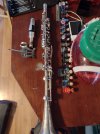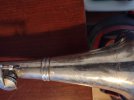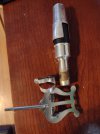Bought a Conn Clarinet for 40 bucks at a swapmeet a few years ago haven't played it yet. Serial number is C 29678, and the par that connects to the mouth piece has the letter C on it too. Strange ligature that I haven't seen on newer clarinets. Mouth piece cover doesn't look original to me. Has what I assume to be a holder for musical pieces, has the word ELTON on it. The engraving on the bell doesn't have any words written on it so I assume that it could be a fake. Not much else that I know about it since I don't understand the serial numbers thing. Any thoughts?
| Advertisement |  |
Click to advertise with us! |
You are using an out of date browser. It may not display this or other websites correctly.
You should upgrade or use an alternative browser.
You should upgrade or use an alternative browser.
Conn Clarinet
- Thread starter AndrewH
- Start date
It was apparently made around 1914 to 1915ish.
Metal clarinets were popular along with rubber clarinets in the early 1900s mostly for Marching bands and Military bands where they were exposed to the weather. Some were of high quality, but most were mediocre or less.
The better one's had a screw on bell, apparently.
Cheaper ones either were fixed or pulled off, many were apparently made as a "Pan American" brand which was a common stencil in the early 1900s.
Since yours does not appear to have a name in the engraving area it may be the non-pro model. I'm not very sure as I'm not very knowledgeable about metal clarinets, especially Conns.
Metal clarinets were popular along with rubber clarinets in the early 1900s mostly for Marching bands and Military bands where they were exposed to the weather. Some were of high quality, but most were mediocre or less.
The better one's had a screw on bell, apparently.
Cheaper ones either were fixed or pulled off, many were apparently made as a "Pan American" brand which was a common stencil in the early 1900s.
Since yours does not appear to have a name in the engraving area it may be the non-pro model. I'm not very sure as I'm not very knowledgeable about metal clarinets, especially Conns.
I shall add a dissenting opinion and not intending any offense. Please note that I'm not an expert on Pan American instruments or Conn stencils. Also, I'm going off of Steve's experience that this clarinet was made by Conn. I do not have enough Conn clarinet knowledge to accurately identify one.
* Provided the clarinet is a Conn stencil or second line (more on that in a bit), the instrument was probably made closer to the late 1920s or even later.
Conn had different serial number charts for each instrument family (clarinet, saxophone, trumpet, Sarrusophone, etc.), which is annoying. There is no serial number chart directly from Conn or Conn-Selmer that lists stencil or second line serial numbers. The chart I link to is completely synthetic and gives you a "good idea" of when something was made, but it's not the 100% source of truth.
* Pan American was Conn's second line. They were cheaper instruments and could be called "intermediate quality." The design could be totally different from the professional Conn instruments of the time. Emphasis on "could be." As far as saxophones go, some Pan Americans were obvious stencils of Conn New Wonder (and later) instruments wile others were made with the very different Pan American tooling.
* There are lots of professional-quality metal clarinets out there. Gandalfe has a couple of eye popping silver Selmers. There's the famous Wm Haynes Thermocouple clarinet. There's the HN White Silver King clarinet with a sterling silver bell, etc.
* I really liked the tone of my Pan American clarinet. Mind you, I owned it 35 or so years ago, so I could be imagining things .
.
There were metal clarinets with multi-piece bodies and Conn (and others, IIRC) even had tunable "barrels." I would have to do a lot of research to tell you if the majority of one-piece metal clarinets are not professional quality.
> Serial number is C 29678, and the par that connects to the mouth piece has the letter C on it too.
It's possible that this is a C clarinet. You can check that with a digital tuner, provided the horn is in somewhat playable condition.
> Strange ligature that I haven't seen on newer clarinets
Ligatures can be bought separately and there are thousands of different models, so that doesn't help identifying the clarinet, unless you say something like, "My ligature is 15km in diameter. What kind of clarinet mouthpiece would this fit?"
> Has what I assume to be a holder for musical pieces, has the word ELTON on it.
It's called a "lyre." There should be a screw-in mount between the top and bottom "joints," unless it's been removed. The name on the lyre doesn't help in the identification of your horn.
> The engraving on the bell doesn't have any words written on it so I assume that it could be a fake.
As in, "It's really a trumpet"?
While there are instruments from China that are engraved to look passingly similar to just about any make/model, no engraving doesn't really mean much of anything. Personally, I think the big space between the engraving "lines" is for the storefront to stencil something -- but they weren't bothered to do so. I've seen lots of horns like that.
* Provided the clarinet is a Conn stencil or second line (more on that in a bit), the instrument was probably made closer to the late 1920s or even later.
Conn had different serial number charts for each instrument family (clarinet, saxophone, trumpet, Sarrusophone, etc.), which is annoying. There is no serial number chart directly from Conn or Conn-Selmer that lists stencil or second line serial numbers. The chart I link to is completely synthetic and gives you a "good idea" of when something was made, but it's not the 100% source of truth.
* Pan American was Conn's second line. They were cheaper instruments and could be called "intermediate quality." The design could be totally different from the professional Conn instruments of the time. Emphasis on "could be." As far as saxophones go, some Pan Americans were obvious stencils of Conn New Wonder (and later) instruments wile others were made with the very different Pan American tooling.
* There are lots of professional-quality metal clarinets out there. Gandalfe has a couple of eye popping silver Selmers. There's the famous Wm Haynes Thermocouple clarinet. There's the HN White Silver King clarinet with a sterling silver bell, etc.
* I really liked the tone of my Pan American clarinet. Mind you, I owned it 35 or so years ago, so I could be imagining things
There were metal clarinets with multi-piece bodies and Conn (and others, IIRC) even had tunable "barrels." I would have to do a lot of research to tell you if the majority of one-piece metal clarinets are not professional quality.
> Serial number is C 29678, and the par that connects to the mouth piece has the letter C on it too.
It's possible that this is a C clarinet. You can check that with a digital tuner, provided the horn is in somewhat playable condition.
> Strange ligature that I haven't seen on newer clarinets
Ligatures can be bought separately and there are thousands of different models, so that doesn't help identifying the clarinet, unless you say something like, "My ligature is 15km in diameter. What kind of clarinet mouthpiece would this fit?"
> Has what I assume to be a holder for musical pieces, has the word ELTON on it.
It's called a "lyre." There should be a screw-in mount between the top and bottom "joints," unless it's been removed. The name on the lyre doesn't help in the identification of your horn.
> The engraving on the bell doesn't have any words written on it so I assume that it could be a fake.
As in, "It's really a trumpet"?
While there are instruments from China that are engraved to look passingly similar to just about any make/model, no engraving doesn't really mean much of anything. Personally, I think the big space between the engraving "lines" is for the storefront to stencil something -- but they weren't bothered to do so. I've seen lots of horns like that.
Yup, I don't have much knowledge or really even want to know about Conn instruments. I don't even really like their saxophones. And their later 424, 444 clarinets were okay and nice, et all but I never really had a reason to deal with them. So for the most part I try to avoid anything Conn related.I shall add a dissenting opinion and not intending any offense. Please note that I'm not an expert on Pan American instruments or Conn stencils. Also, I'm going off of Steve's experience that this clarinet was made by Conn. I do not have enough Conn clarinet knowledge to accurately identify one.
* Provided the clarinet is a Conn stencil or second line (more on that in a bit), the instrument was probably made closer to the late 1920s or even later.
Conn had different serial number charts for each instrument family (clarinet, saxophone, trumpet, Sarrusophone, etc.), which is annoying. There is no serial number chart directly from Conn or Conn-Selmer that lists stencil or second line serial numbers. The chart I link to is completely synthetic and gives you a "good idea" of when something was made, but it's not the 100% source of truth.
* Pan American was Conn's second line. They were cheaper instruments and could be called "intermediate quality." The design could be totally different from the professional Conn instruments of the time. Emphasis on "could be." As far as saxophones go, some Pan Americans were obvious stencils of Conn New Wonder (and later) instruments wile others were made with the very different Pan American tooling.
* There are lots of professional-quality metal clarinets out there. Gandalfe has a couple of eye popping silver Selmers. There's the famous Wm Haynes Thermocouple clarinet. There's the HN White Silver King clarinet with a sterling silver bell, etc.
* I really liked the tone of my Pan American clarinet. Mind you, I owned it 35 or so years ago, so I could be imagining things.
There were metal clarinets with multi-piece bodies and Conn (and others, IIRC) even had tunable "barrels." I would have to do a lot of research to tell you if the majority of one-piece metal clarinets are not professional quality.
> Serial number is C 29678, and the par that connects to the mouth piece has the letter C on it too.
It's possible that this is a C clarinet. You can check that with a digital tuner, provided the horn is in somewhat playable condition.
> Strange ligature that I haven't seen on newer clarinets
Ligatures can be bought separately and there are thousands of different models, so that doesn't help identifying the clarinet, unless you say something like, "My ligature is 15km in diameter. What kind of clarinet mouthpiece would this fit?"
> Has what I assume to be a holder for musical pieces, has the word ELTON on it.
It's called a "lyre." There should be a screw-in mount between the top and bottom "joints," unless it's been removed. The name on the lyre doesn't help in the identification of your horn.
> The engraving on the bell doesn't have any words written on it so I assume that it could be a fake.
As in, "It's really a trumpet"?
While there are instruments from China that are engraved to look passingly similar to just about any make/model, no engraving doesn't really mean much of anything. Personally, I think the big space between the engraving "lines" is for the storefront to stencil something -- but they weren't bothered to do so. I've seen lots of horns like that.
there is information about metal instruments, albeit the more higher end ones on silver-clarinet.com
I do appreciate all the words said, I've been posting this clarinet around different forums and people have actually narrowed it down to a HN White clarinet. Makes sense why I couldn't find any info on it since I've been looking in all the wrong places. Now I know what a lyre is thanks. I appreciate the replyI shall add a dissenting opinion and not intending any offense. Please note that I'm not an expert on Pan American instruments or Conn stencils. Also, I'm going off of Steve's experience that this clarinet was made by Conn. I do not have enough Conn clarinet knowledge to accurately identify one.
* Provided the clarinet is a Conn stencil or second line (more on that in a bit), the instrument was probably made closer to the late 1920s or even later.
Conn had different serial number charts for each instrument family (clarinet, saxophone, trumpet, Sarrusophone, etc.), which is annoying. There is no serial number chart directly from Conn or Conn-Selmer that lists stencil or second line serial numbers. The chart I link to is completely synthetic and gives you a "good idea" of when something was made, but it's not the 100% source of truth.
* Pan American was Conn's second line. They were cheaper instruments and could be called "intermediate quality." The design could be totally different from the professional Conn instruments of the time. Emphasis on "could be." As far as saxophones go, some Pan Americans were obvious stencils of Conn New Wonder (and later) instruments wile others were made with the very different Pan American tooling.
* There are lots of professional-quality metal clarinets out there. Gandalfe has a couple of eye popping silver Selmers. There's the famous Wm Haynes Thermocouple clarinet. There's the HN White Silver King clarinet with a sterling silver bell, etc.
* I really liked the tone of my Pan American clarinet. Mind you, I owned it 35 or so years ago, so I could be imagining things.
There were metal clarinets with multi-piece bodies and Conn (and others, IIRC) even had tunable "barrels." I would have to do a lot of research to tell you if the majority of one-piece metal clarinets are not professional quality.
> Serial number is C 29678, and the par that connects to the mouth piece has the letter C on it too.
It's possible that this is a C clarinet. You can check that with a digital tuner, provided the horn is in somewhat playable condition.
> Strange ligature that I haven't seen on newer clarinets
Ligatures can be bought separately and there are thousands of different models, so that doesn't help identifying the clarinet, unless you say something like, "My ligature is 15km in diameter. What kind of clarinet mouthpiece would this fit?"
> Has what I assume to be a holder for musical pieces, has the word ELTON on it.
It's called a "lyre." There should be a screw-in mount between the top and bottom "joints," unless it's been removed. The name on the lyre doesn't help in the identification of your horn.
> The engraving on the bell doesn't have any words written on it so I assume that it could be a fake.
As in, "It's really a trumpet"?
While there are instruments from China that are engraved to look passingly similar to just about any make/model, no engraving doesn't really mean much of anything. Personally, I think the big space between the engraving "lines" is for the storefront to stencil something -- but they weren't bothered to do so. I've seen lots of horns like that.



